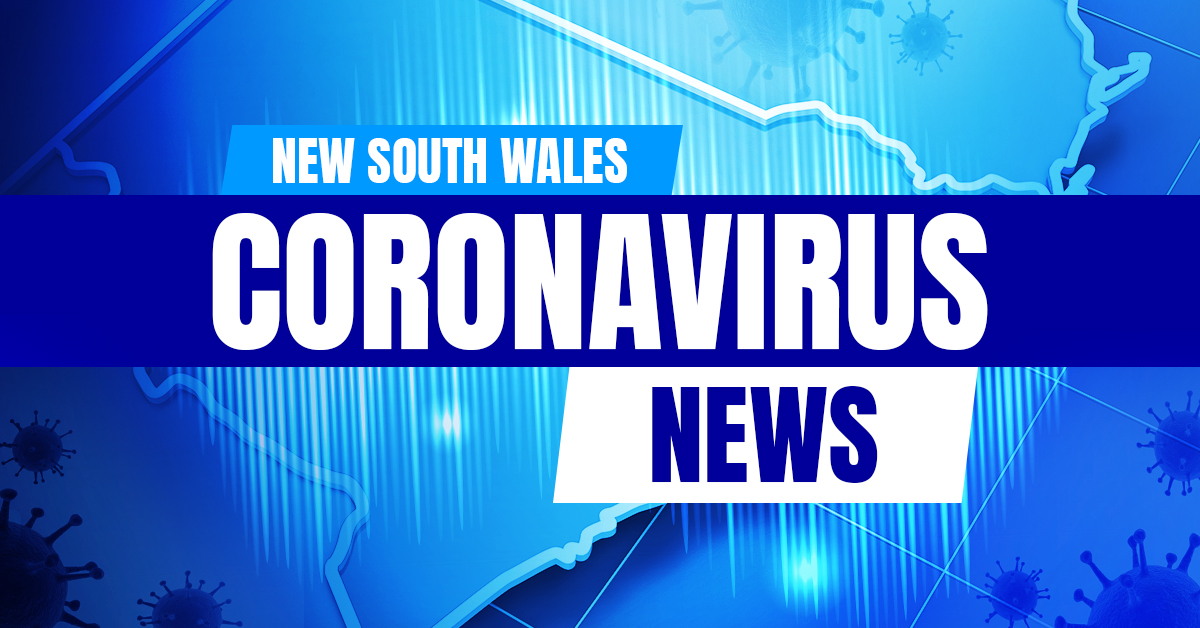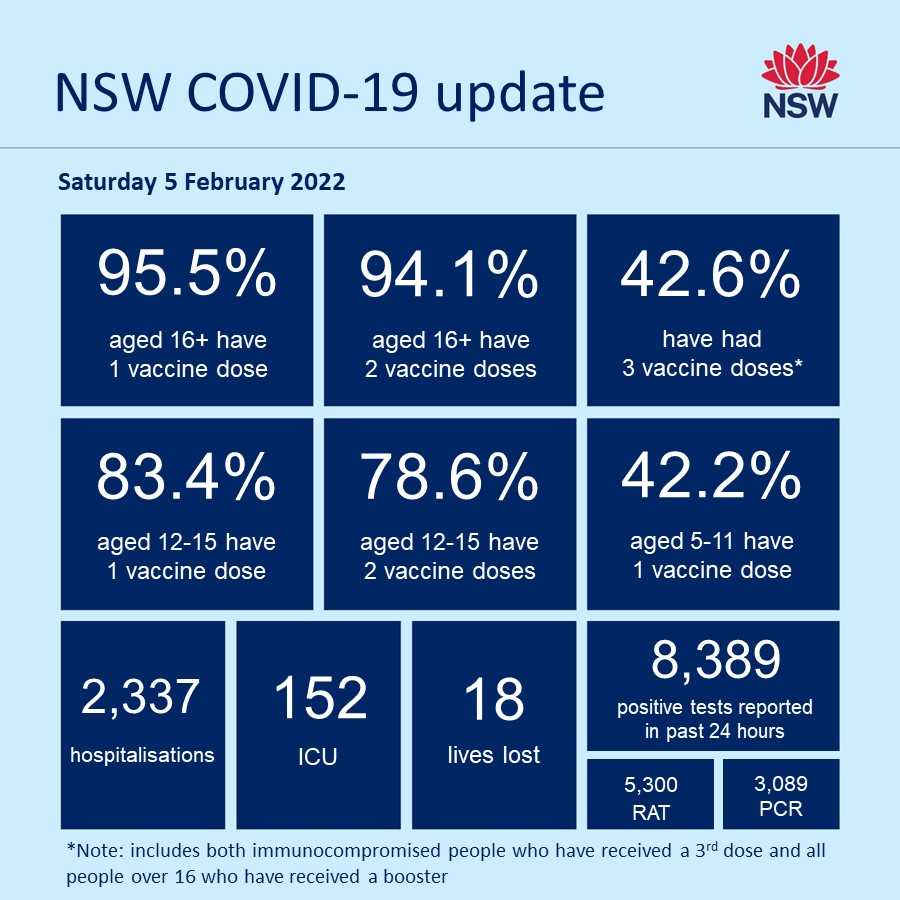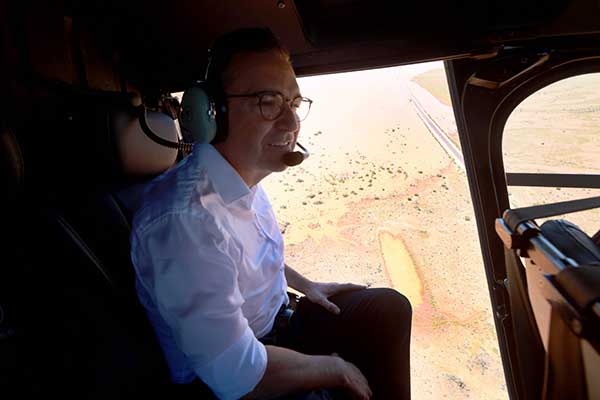Selected
- Details
- Written by NSW News
- Category: Selected
- Hits: 120


- Details
- Written by Grant Broadcasters
- Category: Selected
- Hits: 125

AUSTRALIAN VACCINATION NUMBERS:
* There have been 50,704,279 vaccine doses administered in the national COVID-19 rollout up to Thursday, including 254,407 recorded in the previous 24 hours.
* Of that total, 31,393,111 have been administered by Commonwealth facilities, an increase of 202,345 in the previous 24 hours.
* State and territory facilities have administered 19,311,168 vaccines, an increase of 52,062 in the last 24 hours.
* More than 95 per cent of people aged 16 and over have had at least one dose of a COVID-19 vaccine and 93.6 per cent are double vaccinated.
* A total of 8,631,286 adults have received more than two doses - a booster or top-up shot - an increase of 212,610 in the previous 24 hours.
AUSTRALIAN CORONAVIRUS NUMBERS:
* 32,513 new cases: 10,698 in NSW, 11,238 in Victoria, 6857 in Queensland, 1363 in South Australia, 449 in the ACT, 570 in Tasmania, 1306 in the Northern Territory and 32 in Western Australia.
* The national death toll is 4073 (+84): NSW 1520 (+31), Victoria 2124 (+36), Queensland 247 (+13), South Australia 125 (+three), ACT 27 (+one), NT four, Tasmania 19 and WA nine. (Two Queensland residents who died in NSW have been included in the official tolls of both states).
GLOBAL CORONAVIRUS NUMBERS:
* Cases: at least 388,066,090
* Deaths: at least 5,712,458
* Vaccine doses administered: 10,011,691,400
Data current as at 1700 AEDT on February 4, taking in federal and state/territory government updates and Johns Hopkins Coronavirus Resource Centre figures.
© AAP 2022
Image: News
- Details
- Written by Grant Broadcasters
- Category: Selected
- Hits: 165

Economists are sticking to their guns when its comes to predicting a cash rate rise this year, even if the Reserve Bank of Australia's latest economic forecasts suggest it might be some way off.
The RBA released its quarterly statement on monetary policy, predicting faster economic growth in the near term, and sharply rising inflation and a drop in the unemployment rate below four per cent out to mid-2024.
But reiterating comments made by RBA governor Philip Lowe earlier this week, the quarterly statement released on Friday said the board is prepared to be patient as it monitors how the various factors affecting inflation in Australia evolve.
"We have sympathy for some patience from the RBA as it awaits further signs of labour market strength but their implicit base case of 2023 looks a little complacent," RBC Capital Markets chief economist Su-Lin Ong said.
Speculation of an increase in the cash rate from a record low 0.1 per cent - which would be the first increase in more than a decade - gathered pace last month when inflation for the December quarter proved much stronger than expected.
Financial markets are predicting an increase this year starting in May, while economists see a move more likely in August or September, with a further rise before the end of the year.
The RBA has revised its inflation forecast up, with the interest-rate sensitive underlying rate to reach 3.25 per cent by June this year and then level out at 2.75 per cent until at least June 2024.
But at the same time the RBA said at 2.6 per cent, underlying inflation has only just reached the midpoint of the target range for the first time in more than seven years.
"As the board has stated previously, it will not increase the cash rate until actual inflation is sustainably within the two to three per cent target range," the statement said.
Pushed during his address to the National Press Club this week, Dr Lowe conceded it was "plausible" that the RBA could lift the cash rate this year.
Ahead of the December quarter national accounts on March 2, the RBA expects the economy to have grown by five per cent over 2021, rather than three per cent as previously forecast.
It now forecasts growth at 4.25 per cent for 2022.
"Backed by the Morrison government economic plan, which kept businesses in business and Australians in jobs during the greatest economic shock since the Great Depression, Australia has outperformed every major advanced economy and is well on the road to recovery," Treasurer Josh Frydenberg told AAP.
Annual wage growth is anticipated to have picked up to close to 2.5 per cent by the end of 2021, compared with 2.2 per cent in the September quarter, but still lagging the rate of inflation.
Shadow treasurer Jim Chalmers said it confirms what hardworking Australians already know and what the government is desperate for them to ignore.
"Their real wages are going backwards, making it harder for families to make ends meet and keep up with the skyrocketing costs of living," he told AAP.
The December quarter wage price index is due on February 23.
Further out, wage growth is forecast to gradually strengthen further as the unemployment rate declines, reaching 3.25 per cent by mid-2024, which would be the fastest pace since 2012.
"The RBA's forecasts imply that if it was pressed to give calendar guidance for the first rate hike it would probably indicate the first half of 2023," ANZ head of Australian economics David Plank said.
"We are earlier than this because we are more optimistic about wages growth."
The unemployment rate is expected to further fall to four per cent by June compared with a 13-year low of 4.2 per cent currently.
It is then expected to drop even lower to 3.75 per cent, cracking the four per cent barrier for the first time in 50 years.
© AAP 2022
Image: https://pixabay.com/photos/australian-dollar-money-currency-2874029/ (free image)
- Details
- Written by Grant Broadcasters
- Category: Selected
- Hits: 119

Repairs and reopening of the Stuart Highway, still flooded after an outback deluge, remains "priority number one" as South Australia looks to the federal government for disaster relief funding.
Premier Steven Marshall toured some of the affected areas in the state's north on Thursday to see the extent of the damage and to thank volunteers and emergency service workers for their efforts.
He said water over the Stuart Highway had receded from about 45 centimetres to 30 centimetres and good weather in coming days should help.
"This is priority number one - being able to get that water off the road, assess the damage and get that road back and operational as quickly as possible," he said.
"It's absolutely crucial we get that stood up as quickly as possible."
Nine food and supply drops have now been conducted into Coober Pedy, north of where the highway is cut, with two more expected for Thursday.
Restoring supplies to the town meant outlying communities could similarly restock.
The RAAF was also helping to evacuate some stranded tourists, the premier confirmed.
In other areas, chartered aircraft had been used to take supplies into the Indigenous APY lands where almost all roads remain impassable.
While some concerns remained for pastoralists across the region, especially those running low on diesel fuel.
Mr Marshall said it was fortunate that forecast rain overnight did not eventuate and floodwaters were starting to recede.
But he said the full extent of the damage to the highway was still to be determined and the time frame for repairs remained unclear.
Supplies to both the Northern Territory and Western Australia also remained under stress with train lines damaged by flooding at 18 separate spots across a 300-kilometre section of track.
"This is a mammoth exercise. There are many, many more weeks ahead of this recovery," Mr Marshall said.
"The reality is, this is a one in 200-year flood event. There's been plenty of heavy rain in this area before, but this is quite extreme.
"It's put this entire part of the state under enormous pressure."
State Emergency Service Regional Commander Trevor Arnold said the rain event in the north had been "unprecedented".
He said volunteers had responded to hundreds of calls for assistance, including eight swift-water rescues and recovering other people trapped between flooded creeks.
"There was a lot of people who drove through floodwaters against all the advice. But we're not there to judge, we're there to help," he said.
Mr Arnold said another assessment of water levels over the Stuart Highway would be conducted on Thursday.
"But it's not just the fact that the water needs to recede, it's the damage that may have been done to the road before people can drive on it," he said.
© AAP 2022
Photo: South Australian Premier Steven Marshall inspects flood waters over where Sturt Highway has been cut off near Glendambo, SA, Thursday, February 3, 2022. South Australian Premier Steven Marshall has visited the state's flood-hit regions as the state looks to the commonwealth for financial help. (AAP Image/Pool, Kelly Barnes)
Page 87 of 191